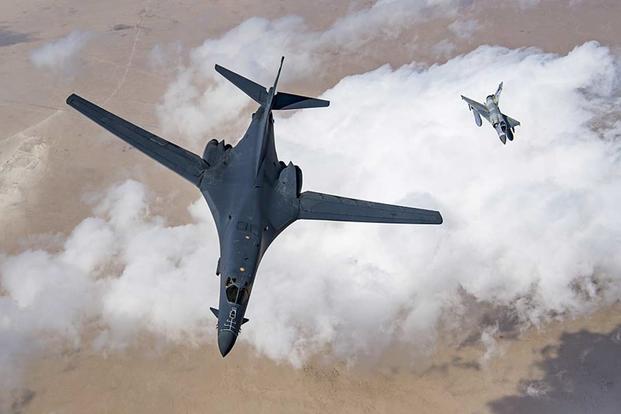The U.S. Air Force has grounded the entire B-1B Lancer bomber fleet, marking the second fleetwide stand-down in about a year.
Officials with Air Force Global Strike Command said that, during a routine inspection of at least one aircraft, airmen found a rigged "drogue chute" incorrectly installed in the ejection seat egress system, a problem that might affect the rest of the fleet.
"The drogue chute corrects the seat before the parachute deploys out of the seat," said Capt. Earon Brown, a spokesman with Air Force Global Strike Command.
The issue is "part of the egress system," or the way airmen exit the bomber in an emergency, Brown told Military.com on Thursday. The problem does not appear to be related to the issues that occurred last year, AFGSC said.
"There are procedural issues of how [the drogue chute is] being put into place," Brown said.
Related content:
- B-1 Ejection Seat Not to Blame for Bomber Mishap, Manufacturer Says
- Air Force Grounds Entire B-1 Bomber Fleet Over Ejection Seat Concerns
- SecAF Reveals Details of B-1 Flameout as Bomber Stand-Down Ends
Officials will "look at each aircraft [para]chute system and make sure they are meeting technical order requirements to employ" the drogue chute appropriately, he added. The B-1 has four seats, for the pilot, co-pilot and two weapons systems officers in the back.
AFGSC commander Gen. Timothy Ray on Thursday directed the stand-down for "a holistic inspection of the entire egress system," according to a press release. "The safety stand-down will afford maintenance and Aircrew Flight Equipment technicians the necessary time to thoroughly inspect each aircraft."
Brown said the Air Force does not have a timeline for when fleet will be back in the air, but said the fixes are a "high priority."
The bombers will return to flight "as the issues, any issues, get resolved," he said, adding that B-1s are not currently deployed overseas.
Last year, the command grounded the fleet over safety concerns related to the Lancer's ejection seats. The stand-down was a result of an emergency landing by a B-1 on May 1, 2018, at Midland Airport in Texas.
Air Force Secretary Heather Wilson confirmed speculation at the time that the B-1, out of Dyess Air Force Base, Texas, had to make an emergency landing after an ejection seat didn't blow.
The B-1 crew "were out training," she said during a May speech at the Defense Communities summit in Washington, D.C.
Local media reported at the time the B-1B was not carrying weapons when it requested to land because of "an engine flameout." Weeks later, images surfaced on Facebook purporting to show the aircraft with a burnt-out engine. Photos from The Associated Press and Midland Reporter-Telegram also showed the B-1B, tail number 86-0109, was missing a ceiling hatch, leading to speculation an in-flight ejection was attempted.
Officials ordered a stand-down on June 7, 2018, which lasted three weeks while the fleet was inspected. Months after the incident, UTC Aerospace Systems, manufacturer of the bomber's ACES II ejection seat, said the seat itself is not the problem.
After coordinating with the Air Force, UTC determined "there's an issue with the sequencing system," said John Fyfe, director of Air Force programs for UTC.
It had been implied "that the ejection seat didn't fire, when in fact the ejection seat was never given the command to fire," Fyfe told Military.com in September.
"This particular B-1, [the sequence system] was not ours," he said, adding that there are multiple vendors for the sequencing systems.
-- Oriana Pawlyk can be reached at oriana.pawlyk@military.com. Follow her on Twitter at @Oriana0214.














